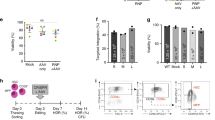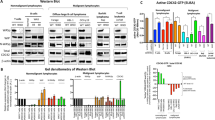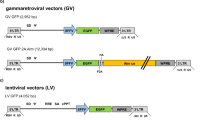Abstract
T-cell dysfunction is thought to be central to the immunodeficiency state seen in patients with the Wiskott–Aldrich syndrome (WAS). Aspects of the WAS phenotype have been corrected in other cell types on introduction of the normal WAS protein (WASP), but the potential for correction of the T-cell defects has not been evaluated. Here we demonstrate that an oncoretroviral vector encoding WASP and green fluorescent protein (GFP), and pseudotyped with the RD114 envelope protein, efficiently transduces primary human T cells derived from WAS patients. Transcription initiated at the oncoretroviral long terminal repeat (LTR) results in levels of WASP that, while lower than those seen in normal control T cells, resulted in correction of the deficient proliferative response to T-cell receptor (TCR) stimulation characteristic of WAS. IL2 secretion after TCR stimulation was partially corrected. Control primary T cells transduced with the same vector responded normally to TCR stimulation, and showed no increase in WASP expression. The demonstration that correction of T cell defects can be achieved by gene transfer supports continued efforts to develop gene therapy for WAS.
This is a preview of subscription content, access via your institution
Access options
Subscribe to this journal
Receive 12 print issues and online access
$259.00 per year
only $21.58 per issue
Buy this article
- Purchase on Springer Link
- Instant access to full article PDF
Prices may be subject to local taxes which are calculated during checkout



Similar content being viewed by others
References
Wiskott A . Familiarer, angeborener morbus werlhofii. Monatsschrift kinderheilkunde 1936; 68: 212–216.
Aldrich R et al. Pedigree demonstrating a sex-linked recessive condition characterized by draining ears, eczematoid dermatitis and bloody diarrhea. Pediatrics 1954; 13: 133–139.
Ozsahin H et al. Bone marrow transplantation in 26 patients with Wiskott–Aldrich syndrome from a single center. J Pediatr 1996; 129: 238–244.
Mullen CA, Anderson KD, Blaese RM . Splenectomy and/or bone marrow transplantation in the management of the Wiskott–Aldrich syndrome: long-term follow-up of 62 cases. Blood 1993; 82: 2961–2966.
Rimm IJ, Rappeport JM . Bone marrow transplantation for the Wiskott–Aldrich syndrome. Long-term follow-up. Transplantation 1990; 50: 617–620.
Filipovich AH et al. Impact of donor type on outcome of bone marrow transplantation for Wiskott–Aldrich syndrome: collaborative study of the International Bone Marrow Transplant Registry and the National Marrow Donor Program. Blood 2001; 97: 1598–1603.
Snapper SB, Rosen FS . The Wiskott–Aldrich syndrome protein (WASP): roles in signaling and cytoskeletal organization. Annu Rev Immunol 1999; 17: 905–929.
Thrasher AJ, Burns S, Lorenzi R, Jones GE . The Wiskott–Aldrich syndrome: disordered actin dynamics in haematopoietic cells. Immunol Rev 2000; 178: 118–128.
Higgs HN, Pollard TD . Regulation of actin filament network formation through ARP2/3 complex: activation by a diverse array of proteins. Annu Rev Biochem 2001; 70: 649–676.
Molina IJ et al. T cells of patients with the Wiskott–Aldrich syndrome have a restricted defect in proliferative responses. J Immunol 1993; 151: 4383–4390.
Gallego MD, Santamaria M, Pena J, Molina IJ . Defective actin reorganization and polymerization of Wiskott–Aldrich T cells in response to CD3-mediated stimulation. Blood 1997; 90: 3089–3097.
Ariga T et al. Spontaneous in vivo reversion of an inherited mutation in the Wiskott–Aldrich syndrome. J Immunol 2001; 166: 5245–5249.
Wada T et al. Somatic mosaicism in Wiskott–Aldrich syndrome suggests in vivo reversion by a DNA slippage mechanism. Proc Natl Acad Sci USA 2001; 98: 8697–8702.
Candotti F et al. Retrovirus-mediated WASP gene transfer corrects defective actin polymerization in B cell lines from Wiskott–Aldrich syndrome patients carrying ‘null’ mutations. Gene Ther 1999; 6: 1170–1174.
Huang MM et al. Expression of human Wiskott–Aldrich syndrome protein in patients' cells leads to partial correction of a phenotypic abnormality of cell surface glycoproteins. Gene Ther 2000; 7: 314–320.
Burns S et al. Configuration of human dendritic cell cytoskeleton by Rho GTPases, the WAS protein, and differentiation. Blood 2001; 98: 1142–1149.
Leverrier Y et al. Cutting edge: the Wiskott–Aldrich syndrome protein is required for efficient phagocytosis of apoptotic cells. J Immunol 2001; 166: 4831–4834.
Symons M et al. Wiskott–Aldrich syndrome protein, a novel effector for the GTPase CDC42Hs, is implicated in actin polymerization. Cell 1996; 84: 723–734.
Moreau V et al. A complex of N-WASP and WIP integrates signalling cascades that lead to actin polymerization. Nat Cell Biol 2000; 2: 441–448.
Hawley RG, Lieu FH, Fong AZ, Hawley TS . Versatile retroviral vectors for potential use in gene therapy. Gene Ther 1994; 1: 136–138.
Persons DA et al. Retroviral-mediated transfer of the green fluorescent protein gene into murine hematopoietic cells facilitates scoring and selection of transduced progenitors in vitro and identification of genetically modified cells in vivo. Blood 1997; 90: 1777–1786.
Kelly PF et al. Highly efficient gene transfer into cord blood nonobese diabetic/severe combined immunodeficiency repopulating cells by oncoretroviral vector particles pseudotyped with the feline endogenous retrovirus (RD114) envelope protein. Blood 2000; 96: 1206–1214.
Lenardo M et al. Mature T lymphocyte apoptosis–immune regulation in a dynamic and unpredictable antigenic environment. Annu Rev Immunol 1999; 17: 221–253.
Snapper SB et al. Wiskott–Aldrich syndrome protein-deficient mice reveal a role for WASP in T but not B cell activation. Immunity 1998; 9: 81–91.
Zhang J et al. Antigen receptor-induced activation and cytoskeletal rearrangement are impaired in Wiskott–Aldrich syndrome protein-deficient lymphocytes. J Exp Med 1999; 190: 1329–1342.
Strom T, Li X, Cunningham JM, Nienhuis AW . Correction of the murine Wiskott–Aldrich syndrome phenotype by hematopoietic stem cell transplantation. Blood 2002; 99: 4626–4628.
Cosset FL et al. High-titer packaging cells producing recombinant retroviruses resistant to human serum. J Virol 1995; 69: 7430–7436.
Stewart DM et al. Studies of the expression of the Wiskott–Aldrich syndrome protein. J Clin Invest 1996; 97: 2627–2634.
Wada T, Jagadeesh GJ, Nelson DL, Candotti F . Retrovirus-mediated WASP gene transfer corrects Wiskott–Aldrich syndrome T-cell dysfunction. Hum Gene Ther 2002; 13: 1039–1046.
Acknowledgements
We thank Dr Janice Riberdy for assistance in setting up the proliferation assays, and Dr KG Murti for help with the immunofluorescence assays. This work was supported by NHLBI Program Project Grant P01 HL 53749, Cancer Center Support CORE Grant, P30 CA 21765, the Hartwell Center for Bioinformatics and Biotechnology at St Jude Children's Research Hospital, and American Lebanese Syrian Associated Charities (ALSAC).
Author information
Authors and Affiliations
Rights and permissions
About this article
Cite this article
Strom, T., Gabbard, W., Kelly, P. et al. Functional correction of T cells derived from patients with the Wiskott–Aldrich syndrome (WAS) by transduction with an oncoretroviral vector encoding the WAS protein. Gene Ther 10, 803–809 (2003). https://doi.org/10.1038/sj.gt.3301950
Received:
Accepted:
Published:
Issue Date:
DOI: https://doi.org/10.1038/sj.gt.3301950
Keywords
This article is cited by
-
Deletion of Wiskott–Aldrich syndrome protein triggers Rac2 activity and increased cross-presentation by dendritic cells
Nature Communications (2016)
-
Transduction of Human Primitive Repopulating Hematopoietic Cells With Lentiviral Vectors Pseudotyped With Various Envelope Proteins
Molecular Therapy (2010)
-
Suppression of Clonal Dominance in Cultured Human Lymphoid Cells by Addition of the cHS4 Insulator to a Lentiviral Vector
Molecular Therapy (2007)
-
Lentiviral vectors targeting WASp expression to hematopoietic cells, efficiently transduce and correct cells from WAS patients
Gene Therapy (2007)
-
Stem cell transplantation for the Wiskott–Aldrich syndrome: a single-center experience confirms efficacy of matched unrelated donor transplantation
Bone Marrow Transplantation (2006)



